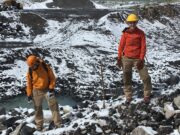Breathable lava suits: volcanologist field-tested and approved
MU student blends fashion, function in lightweight, expedition style clothing interwoven with Kevlar, a heat and abrasive-resistant fiber
June 25th, 2019
COLUMBIA, Mo. – When working near lava at 1,300 to 2,000 degrees Fahrenheit, the terms ‘lightweight’ and ‘comfortable’ might not apply to a volcanologist’s protective clothing.
A volcanologist’s “wish list” for an ideal field suit to wear while working around an active volcano might include flame resistance, abrasion resistance and durability; plenty of pockets for field books, pens, markers, cell phone, GPS and rock samples; clips for attaching hammers and a helmet; and lightweight fabric that is easy to move when wearing. With the help of a University of Missouri graduate student in the College of Human Environmental Sciences, these wishes are turning into reality.
“My designs are based on functional, expressive and aesthetic elements,” said Abby Romine, a graduate student in the Department of Textile and Apparel Management. “For my first prototype, I gathered ideas from students in geological sciences and wanted to make something that was not only functional in all types of environments, but aesthetically pleasing as well.”
Using fabric donated from Mizzou alumna Kathryn Knight at FirstSpear, a tactical gear company in St. Louis, Romine created her second version of the prototype suits for Alan Whittington, chair of geological sciences, and his team of three graduate students in the Department of Geological Sciences at the MU College of Arts and Science. Romine’s four custom suits feature lightweight fabric — for breathability and movement — interwoven with large strips of Kevlar for abrasion and flame resistance. Prior to this project, Romine had never before worked with Kevlar, a heat and abrasive-resistant fiber.
Whittington and his team field-tested Romine’s prototype suits earlier this year in Colorado and were pleased with the results.
“We tested them on a week long field trip in Colorado, and they were the most comfortable field pants I’ve ever worn,” Whittington said. “I’ve been into outdoor gear since the 1980s. People want to buy gear that is expedition-level engineered, so I can see this as a good marketing opportunity beyond just volcanologists. If I had to choose between a commercial brand of work pants and these pants, I would pick these every time.”
Nearly a decade ago, while Whittington was stuck overnight on a volcano in Guatemala, he began thinking about what would make the ideal protective clothing for volcanologists. At the time, he was going through at least one pair of commercial work pants during a single season of field work around volcanos. After meeting Pamela Norum, chair of the Department of Textile and Apparel Management, Whittington thought his wish for an ideal field suit might become reality. Norum shared the idea with her department, and Kristen Morris, an assistant professor in the Department of Textile and Apparel Management, suggested Romine could help.
“The best thing about working with Dr. Whittington and his team was being able to use their specific measurements to customize specific elements of my design,” Romine, a veteran of the U.S. Army, said. “By being able to work directly with volcanologists, it gave me better ideas for my design.”
Romine said she plans to give her design details to FirstSpear to implement into production. The prototype designs will be on display June 25 at Gwynn Hall.
Editor’s Note: For more on the story, please see: Volcano Pants: The Latest Fashion Trend from MU Geologists and a Graduate Student



 Photos (4):
Photos (4):